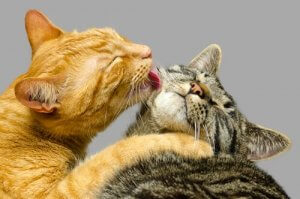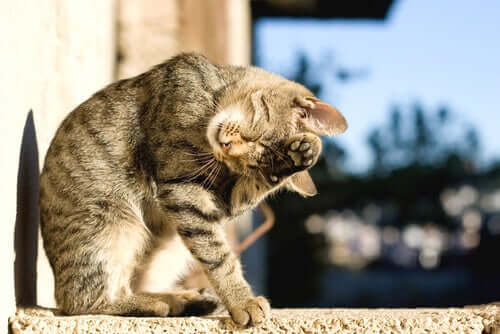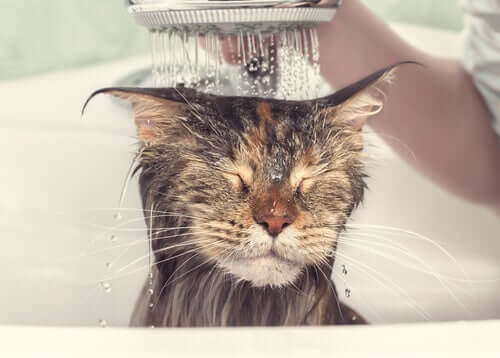The Cat's Curious Cleaning Routine


Written and verified by the biologist Paloma de los Milagros
Did you know that cats have a very curious cleaning routine? It’s interesting to see that when they wash themselves, they follow very specific steps. It may appear to us that it’s just a simple daily cleanse, when in reality it’s actually a real ritual.
The reason why they do this is not only to get rid of knots and dirt, but to also extend the natural sebum of the skin which helps maintain a healthy coat.
So, however clean a cat may be after its bath, it will always do its licking routine, and will even lick itself several times a day.
There are people who worry about it as they think their cat could be nervous. However, it’s interesting to know that it’s for vanity reasons. Cats wash regularly to show that they care about their appearance and they want others to see them looking good. So much so that when two or more cats live together they groom each other out of affection.
The cat’s cleaning routine
Just as each person has their own daily cleaning routine, each cat also has its own ritual, established according to their own comfort or simply what is best for them.
However, most of them share the same pattern, which is rarely altered.
First, they moisten one of their front legs to rub their head, including eyes, ears, cheeks and chin. Next, they will do the same with the other leg to clean the opposite side, which they couldn’t reach before.

Even when the cat has had a bath, it will still groom itself. This doesn’t mean that they still feel “dirty” or poorly bathed. There are other reasons behind their ritual.
Cats then lick their necks, forelimbs, flanks, and abdomen. This is the section that can vary between different animals, but generally a descending order tends to be followed. Finally, they proceed to wash their bellies, genital area, hind legs and tail to its very tip.
The time spent on each area or frequency of licking depends on the animal. However, there are times when this behavior becomes compulsive and a vet or ethnologist has to step in to help.
Sometimes a cat grooms itself too often because of tension, stress, or fear, in such a way that cats use the ritual as a form of therapy.
This obsessive behavior must be treated, not only for the cat’s mental health, but because it can end up causing skin lesions, such as abrasions or local alopecia.
Licking doesn’t replace washing
Although cats wash daily, their saliva isn’t enough to remove possible dirt, especially if they spend a lot of time outside the home. For this reason, even if it’s just occasionally, it’s important for owners to give their pets a thorough cleaning.

Cats generally dislike water, so bathing them can be a bad experience for them. To make cleaning them easier, you can buy dry cleaning foams from specialized stores. Using it alongside sufficient brushing will help remove possible knots, dust and hair and it may be sufficient with indoor cats too.
However, when cats get out often, especially in winter, a bath with soap and water will be necessary. In these situations, the owner needs to be patient and show a lot of love and affection to make the experience as pleasant as possible.
Did you know that cats have a very curious cleaning routine? It’s interesting to see that when they wash themselves, they follow very specific steps. It may appear to us that it’s just a simple daily cleanse, when in reality it’s actually a real ritual.
The reason why they do this is not only to get rid of knots and dirt, but to also extend the natural sebum of the skin which helps maintain a healthy coat.
So, however clean a cat may be after its bath, it will always do its licking routine, and will even lick itself several times a day.
There are people who worry about it as they think their cat could be nervous. However, it’s interesting to know that it’s for vanity reasons. Cats wash regularly to show that they care about their appearance and they want others to see them looking good. So much so that when two or more cats live together they groom each other out of affection.
The cat’s cleaning routine
Just as each person has their own daily cleaning routine, each cat also has its own ritual, established according to their own comfort or simply what is best for them.
However, most of them share the same pattern, which is rarely altered.
First, they moisten one of their front legs to rub their head, including eyes, ears, cheeks and chin. Next, they will do the same with the other leg to clean the opposite side, which they couldn’t reach before.

Even when the cat has had a bath, it will still groom itself. This doesn’t mean that they still feel “dirty” or poorly bathed. There are other reasons behind their ritual.
Cats then lick their necks, forelimbs, flanks, and abdomen. This is the section that can vary between different animals, but generally a descending order tends to be followed. Finally, they proceed to wash their bellies, genital area, hind legs and tail to its very tip.
The time spent on each area or frequency of licking depends on the animal. However, there are times when this behavior becomes compulsive and a vet or ethnologist has to step in to help.
Sometimes a cat grooms itself too often because of tension, stress, or fear, in such a way that cats use the ritual as a form of therapy.
This obsessive behavior must be treated, not only for the cat’s mental health, but because it can end up causing skin lesions, such as abrasions or local alopecia.
Licking doesn’t replace washing
Although cats wash daily, their saliva isn’t enough to remove possible dirt, especially if they spend a lot of time outside the home. For this reason, even if it’s just occasionally, it’s important for owners to give their pets a thorough cleaning.

Cats generally dislike water, so bathing them can be a bad experience for them. To make cleaning them easier, you can buy dry cleaning foams from specialized stores. Using it alongside sufficient brushing will help remove possible knots, dust and hair and it may be sufficient with indoor cats too.
However, when cats get out often, especially in winter, a bath with soap and water will be necessary. In these situations, the owner needs to be patient and show a lot of love and affection to make the experience as pleasant as possible.
All cited sources were thoroughly reviewed by our team to ensure their quality, reliability, currency, and validity. The bibliography of this article was considered reliable and of academic or scientific accuracy.
- Feline International. Feline Grooming. (S.f). Recuperado de https://catsinternational.org/feline-grooming/
- Purina One. Cada cuanto puedo bañar a mi gato. (S.f). Recuperado de https://www.purina.es/gato/purina-one/articulos/adulto/cuidados-higiene/cada-cuanto-puedo-banar-a-mi-gato
- Shojai, A. (2019). The Spruce Pets. Understanding Why Cats Groom Themselves. Recuperado de https://www.thesprucepets.com/understanding-cat-grooming-553960
- Eckstein, R. A., & Hart, B. L. (2000). The organization and control of grooming in cats. Applied Animal Behaviour Science, 68(2), 131-140.
- Eckstein, R. A., & Hart, B. L. (2000). Grooming and control of fleas in cats. Applied Animal Behaviour Science, 68(2), 141-150.
This text is provided for informational purposes only and does not replace consultation with a professional. If in doubt, consult your specialist.








